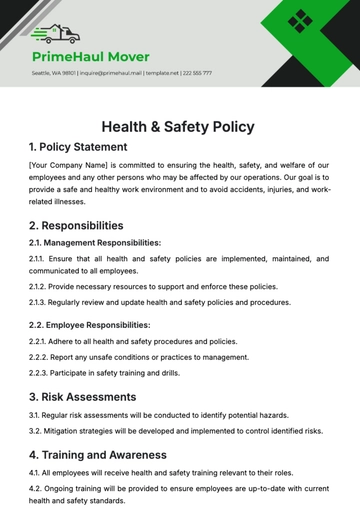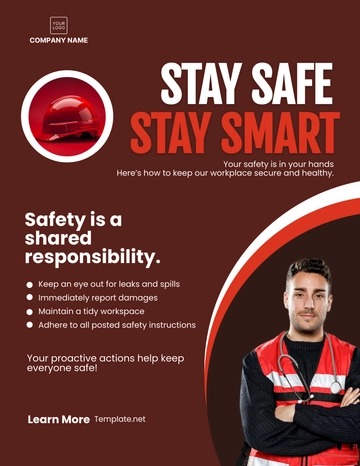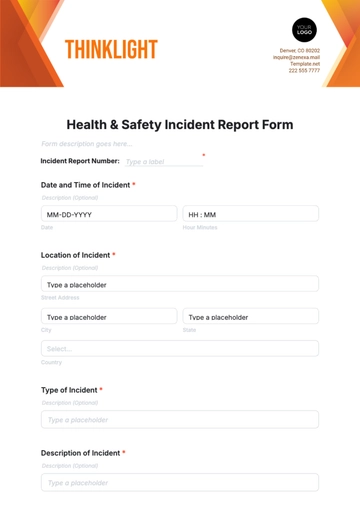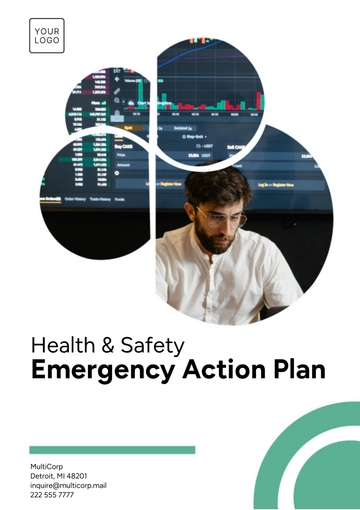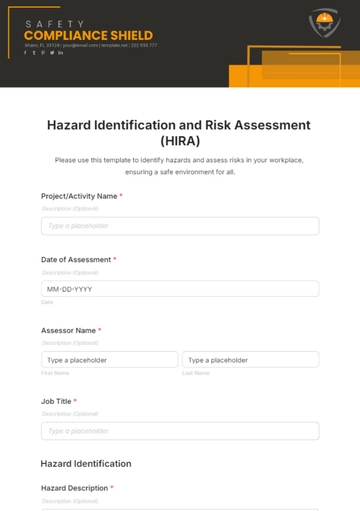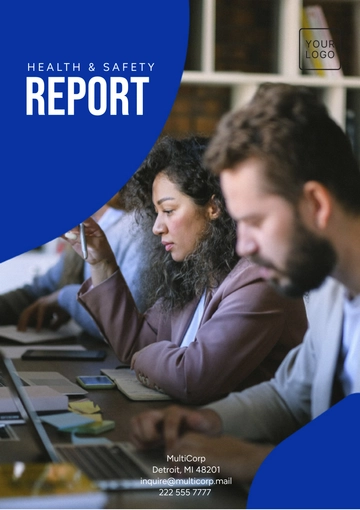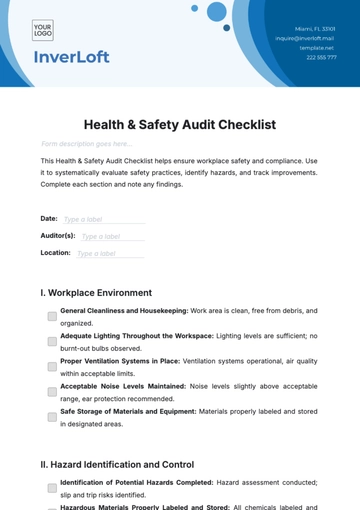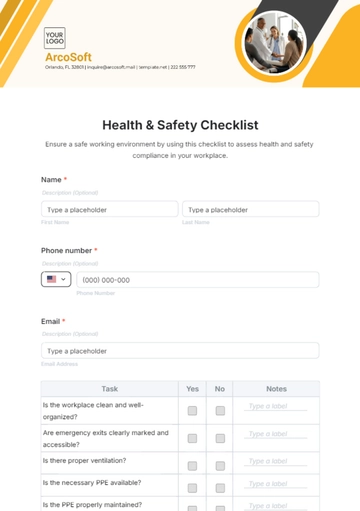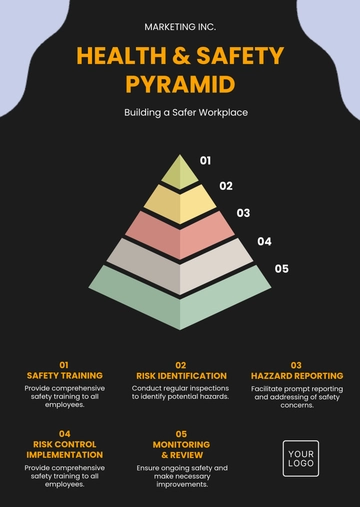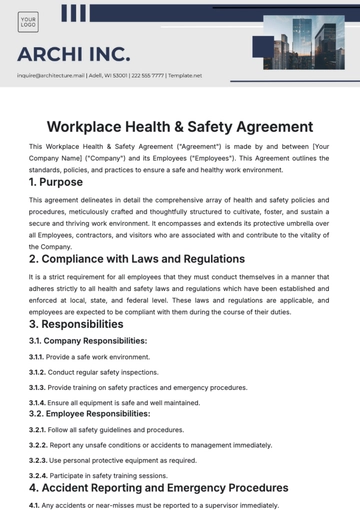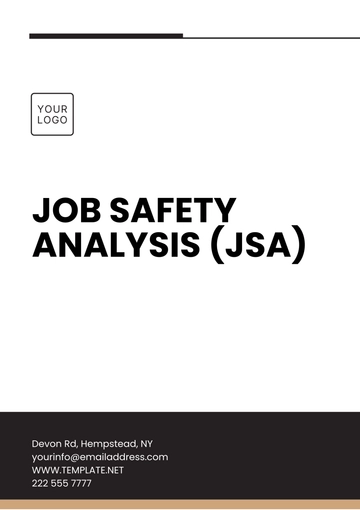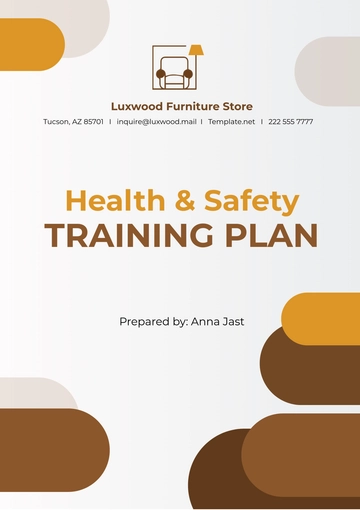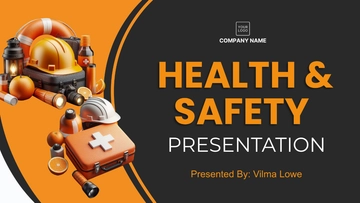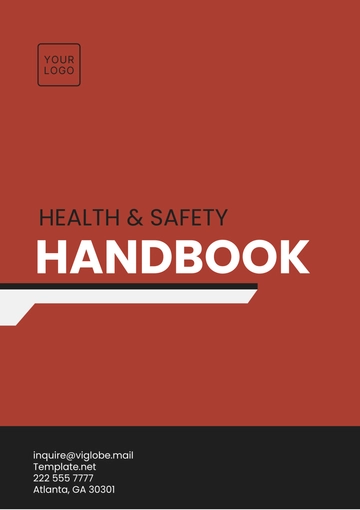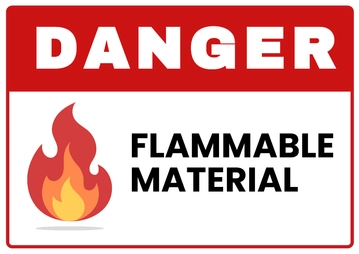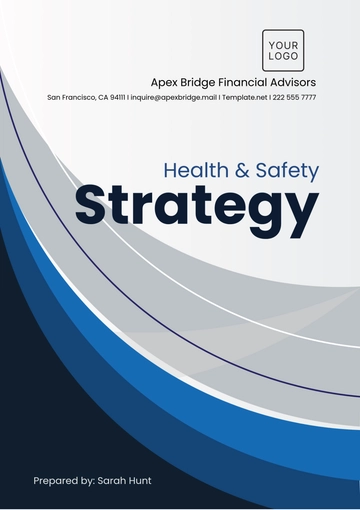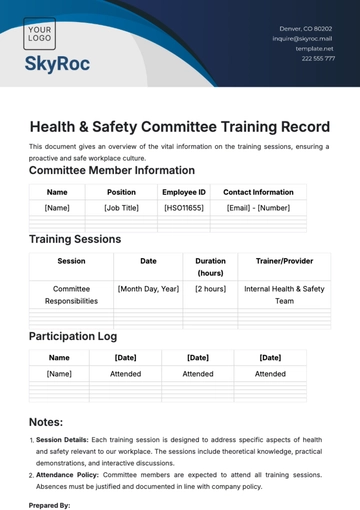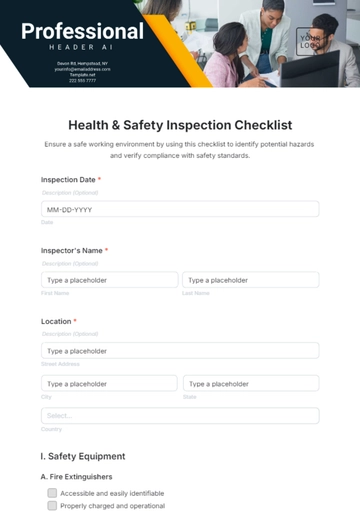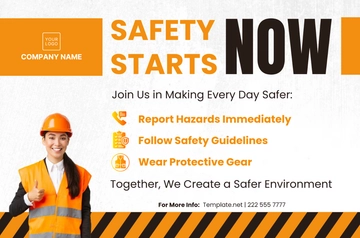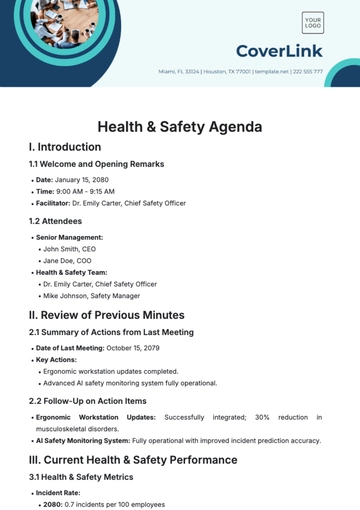Free Health & Safety Training Guide
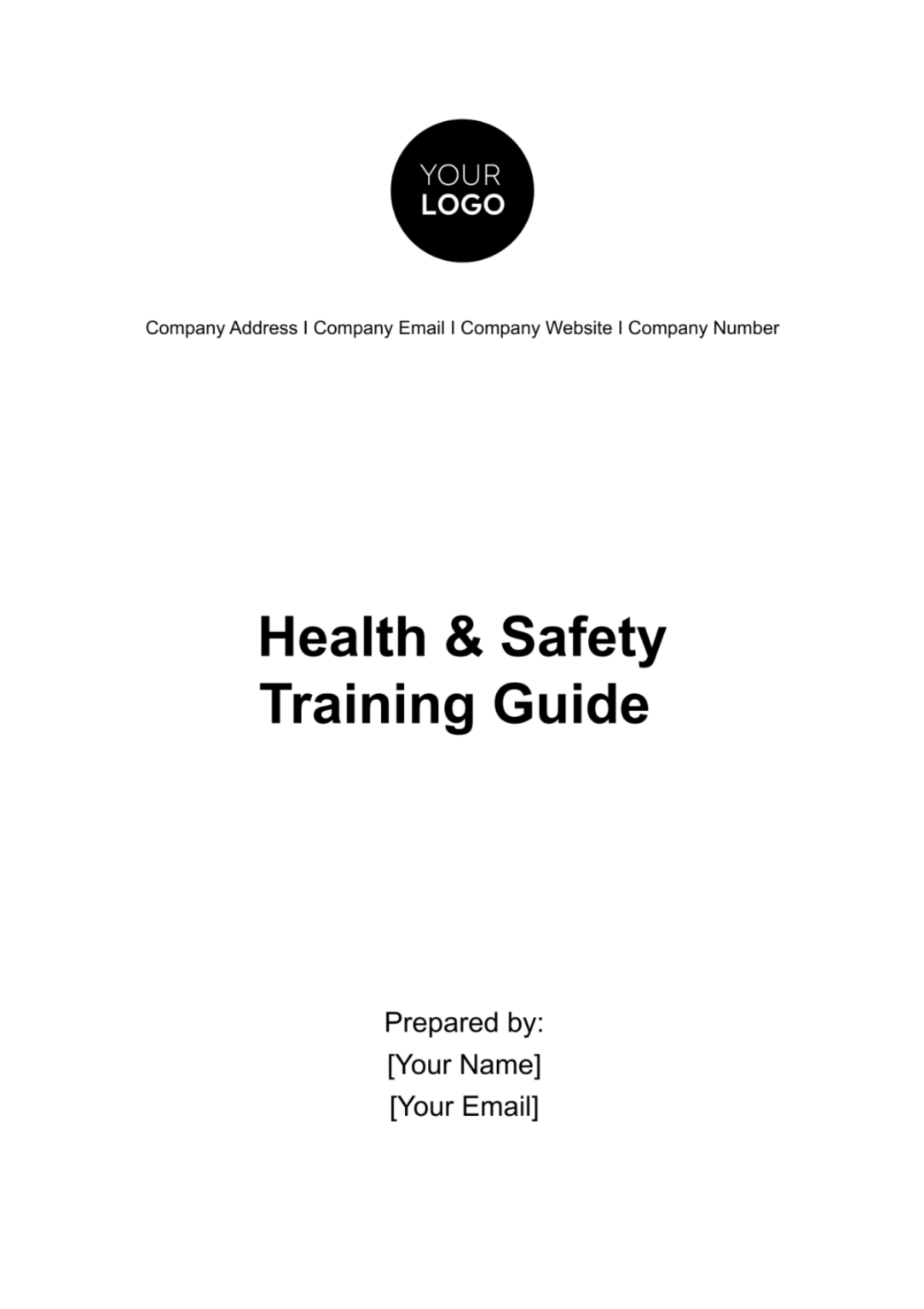
A. Introduction
Welcome to the [Your Company Name] Health & Safety Training Guide. At [Your Company Name], we prioritize the health and safety of our employees and all individuals involved in our operations. This comprehensive guide is designed to provide you with essential information and procedures to ensure a safe and healthy workplace environment.
Following US health and safety standards, this guide outlines the necessary steps, policies, and practices to prevent accidents, protect against hazards, and comply with regulatory requirements. We encourage you to carefully review and actively participate in our commitment to maintaining a culture of safety and well-being. Your safety is our utmost priority.
B. Legal and Regulatory Framework
In this section, we provide an overview of the legal and regulatory framework governing workplace health and safety in the United States. It is essential to understand the legal obligations and standards that guide our practices at [Your Company Name]. Below, you will find a summary of key federal regulations and their implications for our operations.
Regulation | Description |
Occupational Safety and Health Act (OSHA) | Mandates safe and healthful working conditions. |
Hazard Communication Standard (HazCom) | Ensures the communication of chemical hazards. |
Americans with Disabilities Act (ADA) | Prohibits discrimination against individuals with disabilities. |
Environmental Protection Agency (EPA) | Regulates environmental safety and compliance. |
Emergency Planning and Community Right-to-Know Act (EPCRA) | Requires reporting of hazardous chemicals. |
Please be aware that this is not an exhaustive list, and various state and local regulations may also apply. Compliance with these regulations is crucial to maintaining a safe workplace. It is your responsibility to familiarize yourself with these laws and follow them diligently in your daily activities.
C. Responsibilities and Roles
In this section, we outline the responsibilities and roles of individuals within our organization concerning health and safety. Ensuring clarity about who does what is essential for maintaining a safe workplace. Below, you will find a summary of key roles and their corresponding responsibilities.
Role | Responsibilities |
Management |
|
Supervisors |
|
Employees |
|
Health and Safety Committee |
|
Emergency Response Team |
|
D. Risk Assessment and Hazard Identification
In this section, we delve into the critical process of risk assessment and hazard identification. Understanding and mitigating workplace hazards is a cornerstone of our commitment to health and safety. Below, you will find key steps and considerations for identifying and managing risks effectively.
Hazard Identification
Regularly inspect the workplace to identify potential hazards.
Encourage employees to report hazards promptly.
Maintain a hazard log for tracking and resolution.
Risk Assessment
Evaluate the severity and likelihood of identified hazards.
Prioritize risks based on potential harm and exposure.
Develop control measures to mitigate identified risks.
Safety Data Sheets (SDS)
Ensure access to SDS for all hazardous chemicals used.
Train employees on interpreting SDS information.
Job Safety Analysis (JSA)
Conduct JSAs for high-risk tasks.
Involve employees in JSA development.
Incident Investigation
Investigate incidents and near-misses to identify root causes.
Implement corrective actions to prevent recurrence.
E. Safety Policies and Procedures
At [Your Company Name], our commitment to safety is underpinned by clear and effective safety policies and procedures. This section outlines the six key steps that form the foundation of our safety framework.
By adhering to these steps, we foster a culture of safety that benefits all. Your dedication to following our safety policies and procedures is integral to our collective well-being.
F. Emergency Response
In this section, we emphasize the importance of preparedness and effective emergency response procedures. Rapid and well-coordinated responses to emergencies can prevent injuries and save lives. Here are five key elements of our emergency response plan:
Emergency Contacts
Maintain a list of emergency contacts, including local authorities, medical facilities, and internal response teams.
Evacuation Plans
Develop and communicate clear evacuation routes and assembly points. Conduct regular drills to ensure everyone knows what to do.
First Aid
Ensure that designated personnel are trained in first aid and that first aid kits are readily available.
Emergency Equipment
Regularly inspect and maintain emergency equipment, such as fire extinguishers and safety showers.
Communication
Establish reliable communication channels for alerting employees and coordinating response efforts during emergencies.
G. Personal Protective Equipment (PPE)
In this section, we emphasize the vital role of Personal Protective Equipment (PPE) in safeguarding individuals in hazardous work environments. Proper selection, use, and maintenance of PPE are essential for your safety. Here are five key aspects of our PPE program:
Assessment
Identify workplace hazards that require PPE and conduct risk assessments to determine the appropriate gear.
Selection
Choose the right PPE for the specific hazards, including items like helmets, gloves, eye protection, respiratory protection, and hearing protection.
Training
Provide comprehensive training on PPE usage, maintenance, and limitations to ensure proper understanding.
Fit and Maintenance
Ensure that PPE fits correctly, is well-maintained, and is regularly inspected for damage or wear.
Compliance
Encourage and enforce PPE use among employees, making it a non-negotiable part of workplace safety.
Your commitment to using the prescribed PPE is crucial for personal safety and maintaining a secure work environment at [Your Company Name]. Proper PPE use not only protects you but also those around you.
H. Training and Education
In this section, we underscore the significance of training and education in promoting a culture of safety at [Your Company Name]. Our commitment to your safety begins with comprehensive training. Here are four key components of our training and education program:
Orientation Training
New employees receive an introduction to our safety policies and procedures as part of their onboarding process.
Job-Specific Training
Employees receive specialized training tailored to their roles, ensuring they understand and can mitigate job-related risks.
Refresher Training
Regularly scheduled refresher courses keep everyone up to date on safety protocols and best practices.
Emergency Response Drills
We conduct periodic drills to test and improve responses to potential emergencies.
I. Incident Reporting and Investigation
In this section, we emphasize the importance of promptly reporting and thoroughly investigating workplace incidents. Transparent reporting and analysis enable us to identify root causes, prevent recurrences, and continuously improve our safety measures. Below are the key steps of our Incident Reporting and Investigation procedure:
J. Safety Culture and Continuous Improvement
In this section, we highlight the importance of fostering a strong safety culture and a commitment to continuous improvement. A robust safety culture not only prevents accidents but also promotes innovation and efficiency. Here are five key principles guiding our approach:
Leadership Engagement
Leadership sets the tone for a safety culture through active involvement and leading by example.
Employee Involvement
Encourage employees to actively participate in safety initiatives and provide feedback.
Continuous Learning
Promote ongoing education and training to stay current with best practices.
Feedback Mechanisms
Establish channels for reporting safety concerns and suggestions for improvement.
K. Performance Metrics
Monitor and analyze safety performance metrics to identify areas for enhancement.
By embracing these principles, we collectively contribute to a safer and more productive workplace at [Your Company Name]. Remember that safety is a shared responsibility, and your dedication to a strong safety culture is invaluable.
We appreciate your commitment to safety and continuous improvement. Together, we create a safer work environment for everyone at [Your Company Name], ensuring the well-being of all. Thank you for your dedication to our safety culture.
- 100% Customizable, free editor
- Access 1 Million+ Templates, photo’s & graphics
- Download or share as a template
- Click and replace photos, graphics, text, backgrounds
- Resize, crop, AI write & more
- Access advanced editor
Introducing the Health & Safety Training Guide Template from Template.net! Crafted to streamline workplace safety education, this editable and customizable template offers an intuitive interface powered by our AI Editor Tool. Elevate your training materials effortlessly, ensuring compliance and employee well-being with ease. Upgrade your safety initiatives today!

